The book begins by examining in dynamic terms Planck’s constant
h as the “
Least Action” to end in the operational logic of quantum gravity. This topic has so far been addressed by physicists with little clarity and too much mathematics. It is useful to recall a famous suggestion that Feynman gave to his students, namely to ‘
write your equations only when you know the result’.
The scenario in which this research takes place is a quantized space formed by areolas, or pixels, with solutions of continuity along their edges. The first question that immediately comes to mind is the following: “
On a quantized space made up of isolated pixels by definition, how does a particle move to pass through non-space?” In this passage, Debroglie’s strange hypothesis of wave-matter helps us! Obviously the pixels do not move, it is more efficient to think that the information is translated between pixels by means of links that function as
information channels. Therefore, the particle that is matter on the pixel of space is transformed into waves along the links, conveying the information from one point to another through probabilistic schemes required by the
uncertainty principle. How are these phenomena explained? Here is introduced the Sub-Quantum Mechanism (SQM), a paradigm able to clarify several questions of modern physics and also to provide a logical explanation both for the Inertia of bodies and for Gravity without mathematical subterfuges. Eventually it will be understood that general and special relativity are a corollary of quantum mechanics, nor could it be otherwise .
About a century and a half ago, the Austrian physicist Ernst Mach elaborated new considerations on the equivalence of gravitational and inertial mass. Mach hypothesized that the masses attracted each other
by exchanging accelerations, an idea that had interested Einstein helping him to elaborate general relativity theory. However, the exchange of accelerations between masses in space at this time had been explained in an obscure logical framework since quantum mechanics was not yet known.
The paradigm of the Sub-quantic Mechanism, discussed in this book, theorizes that the
masses are nothing more than a set of accelerations. The latter intervene, moment by moment, in the dynamics of the intermittent materialization of bodies on space. The residues of such an intrinsic process of the matter, driven by Heisenberg’s Uncertainty Principle, generate these acceleration exchanges between masses that are the necessary key to understand the quantum gravity, as a whole.
Finally, this paradigm explains the logic on what Einstein himself failed to explain, namely: the profound reason why the presence of mass curves spacetime. In fact, it is precisely the acceleration packets released during the materialization process that stress the spatial structure through an oscillating convexity-concavity process present in the intermittent formation of matter. The result is that matter is intimately an impermanent entity.
h as the “
Least Action” to end in the operational logic of quantum gravity. This topic has so far been addressed by physicists with little clarity and too much mathematics. It is useful to recall a famous suggestion that Feynman gave to his students, namely to ‘
write your equations only when you know the result’.
The scenario in which this research takes place is a quantized space formed by areolas, or pixels, with solutions of continuity along their edges. The first question that immediately comes to mind is the following: “
On a quantized space made up of isolated pixels by definition, how does a particle move to pass through non-space?” In this passage, Debroglie’s strange hypothesis of wave-matter helps us! Obviously the pixels do not move, it is more efficient to think that the information is translated between pixels by means of links that function as
information channels. Therefore, the particle that is matter on the pixel of space is transformed into waves along the links, conveying the information from one point to another through probabilistic schemes required by the
uncertainty principle. How are these phenomena explained? Here is introduced the Sub-Quantum Mechanism (SQM), a paradigm able to clarify several questions of modern physics and also to provide a logical explanation both for the Inertia of bodies and for Gravity without mathematical subterfuges. Eventually it will be understood that general and special relativity are a corollary of quantum mechanics, nor could it be otherwise .
About a century and a half ago, the Austrian physicist Ernst Mach elaborated new considerations on the equivalence of gravitational and inertial mass. Mach hypothesized that the masses attracted each other
by exchanging accelerations, an idea that had interested Einstein helping him to elaborate general relativity theory. However, the exchange of accelerations between masses in space at this time had been explained in an obscure logical framework since quantum mechanics was not yet known.
The paradigm of the Sub-quantic Mechanism, discussed in this book, theorizes that the
masses are nothing more than a set of accelerations. The latter intervene, moment by moment, in the dynamics of the intermittent materialization of bodies on space. The residues of such an intrinsic process of the matter, driven by Heisenberg’s Uncertainty Principle, generate these acceleration exchanges between masses that are the necessary key to understand the quantum gravity, as a whole.
Finally, this paradigm explains the logic on what Einstein himself failed to explain, namely: the profound reason why the presence of mass curves spacetime. In fact, it is precisely the acceleration packets released during the materialization process that stress the spatial structure through an oscillating convexity-concavity process present in the intermittent formation of matter. The result is that matter is intimately an impermanent entity.
Language English ● Format EPUB ● ISBN 9791220806770 ● File size 1.0 MB ● Publisher streetlib ● Published 2021 ● Downloadable 24 months ● Currency EUR ● ID 7852149 ● Copy protection without












